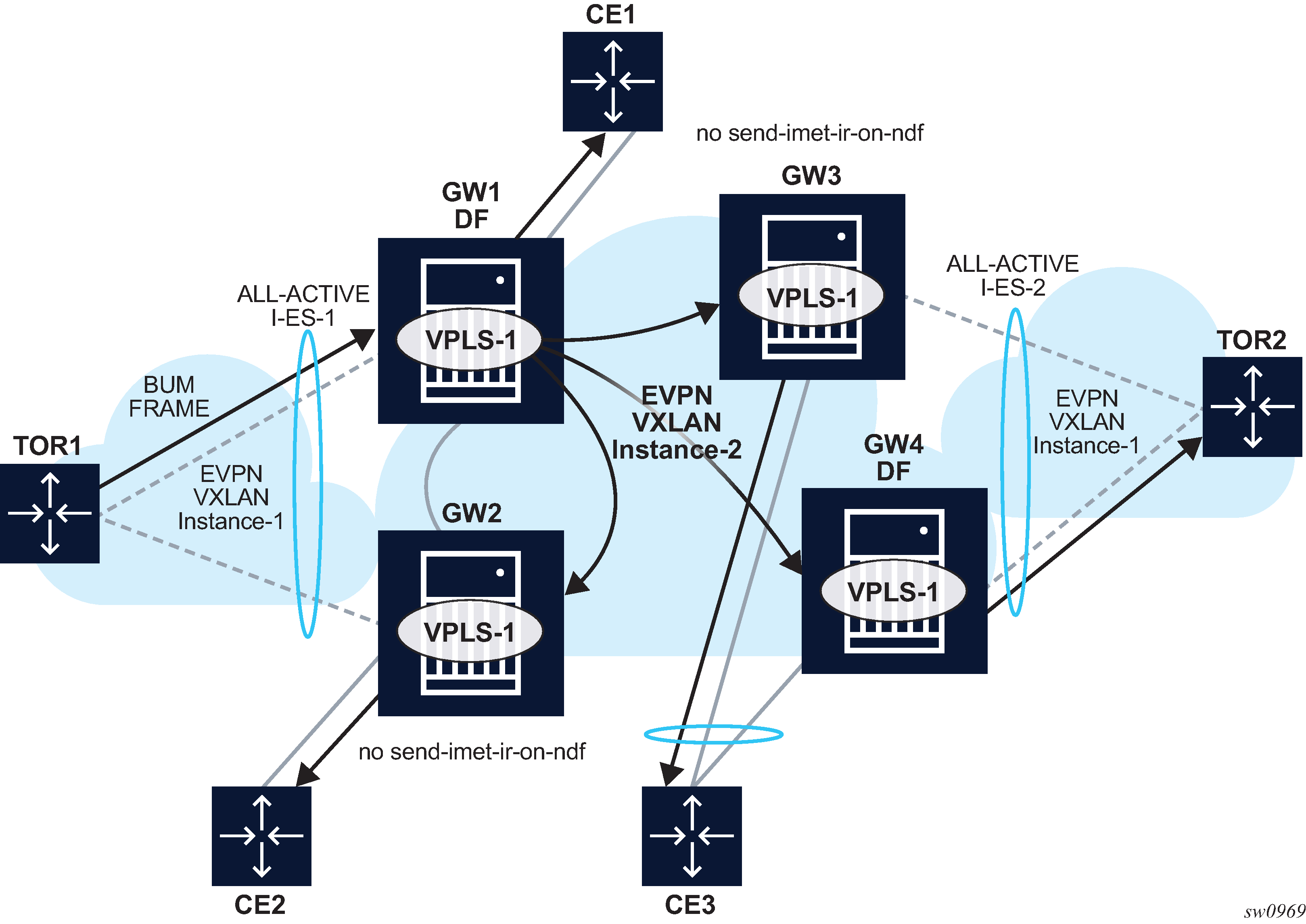The I-ES of network-interconnect VXLAN Ethernet segment is described in I-ES solution for dual BGP instance services. I-ES’s are also supported on VPLS and R-VPLS services with two EVPN-VXLAN instances.
Figure: I-ES in dual EVPN-VXLAN services shows the use of an I-ES in a dual EVPN-VXLAN instance service.

Similar to (single-instance) EVPN-VXLAN all-active multihoming, the BUM forwarding procedures follow the ‟Local Bias” behavior.
At the ingress PE, the forwarding rules for EVPN-VXLAN services are as follows:
-
The no send-imet-ir-on-ndf or rx-discard-on-ndf bum command must be enabled so that the NDF does not forward any BUM traffic.
-
BUM frames received on any SAP or I-ES VXLAN binding are flooded to:
-
local non-ES and single-active DF ES SAPs
-
local all-active ES SAPs (DF and NDF)
-
EVPN-VXLAN destinations
BUM received on an I-ES VXLAN binding follows SHG rules, for example, it can only be forwarded to EVPN-VXLAN destinations that belong to the other VXLAN instance (instance 2), which is a different SHG.
-
-
As an example, in Figure: I-ES in dual EVPN-VXLAN services:
-
GW1 and GW2 are configured with no send-imet-ir-on-ndf.
-
TOR1 generates BUM traffic that only reaches GW1 (DF).
-
GW1 forwards to CE1 and EVPN-VXLAN destinations.
-
The forwarding rules at the egress PE are as follows:
-
The source VTEP is looked up for BUM frames received on EVPN-VXLAN.
-
If the source VTEP matches one of the PEs with which the local PE shares an ES _AND_ a VXLAN service:
-
Then the local PE does not forward to the shared local ES’es (this includes port, lag, or network-interconnect-vxlan ES’es). It forwards though to non-shared ES SAPs unless they are in NDF state.
-
Else, the local PE forwards normally to local ES’es unless they are in NDF state.
-
-
Because there is no multicast label or multicast B-MAC in VXLAN, the only way the egress PE can identify BUM traffic is by looking at the customer MAC DA. Therefore, BM or unknown MAC DAs identify BUM traffic.
-
As an example, in Figure: I-ES in dual EVPN-VXLAN services:
-
GW2 receives BUM on EVPN-VXLAN. GW2 identifies the source VTEP as a PE with which the I-ES-1 is shared, therefore it does not forward the BUM frames to the local I-ES. It forwards to the non-shared ES and local SAPs though (CE2).
-
GW3 receives BUM on EVPN-VXLAN, however the source VTEP does not match any PE with which GW3 shares an ES. Hence GW3 forwards to all local ES’es that are DF, in other words, CE3.
-
The following configuration example shows how I-ES-1 would be provisioned on DCGW1 and the association between I-ES to a specified VPLS service. A similar configuration would occur on DCGW2 in the I-ES.
I-ES configuration:
*A:GW1>config>service>system>bgp-evpn>eth-seg# info
----------------------------------------------
esi 00:23:23:23:23:23:23:00:00:01
service-carving
mode manual
manual
preference non-revertive create
value 150
exit
evi 101 to 200
exit
exit
multi-homing all-active
network-interconnect-vxlan 1
service-id
service-range 1
service-range 1000 to 1002
service-range 2000
exit
no shutdown
Service configuration:
*A:GW1>config>service>vpls# info
----------------------------------------------
vxlan instance 1 vni 1000 create
rx-discard-on-ndf bum
exit
vxlan instance 2 vni 1002 create
exit
bgp
route-target export target:64500:1000 import target:64500:1000
exit
bgp 2
route-distinguisher auto-rd
route-target export target:64500:1002 import target:64500:1002
exit
bgp-evpn
evi 1000
vxlan bgp 1 vxlan-instance 1
ecmp 2
default-route-tag 100
auto-disc-route-advertisement
no shutdown
exit
vxlan bgp 2 vxlan-instance 2
ecmp 2
default-route-tag 200
auto-disc-route-advertisement
mh-mode network
no shutdown
exit
exit
no shutdown
Multi-instance EVPN VPLS/R-VPLS services with two EVPN-MPLS instances do not support I-ESs.
For information about how the EVPN routes are processed and advertised in an I-ES, see the I-ES solution for dual BGP instance services.